 This blog was originally posted by the Education Commission of the States on the EdNote education policy blog. To see the other posts in this series, click here.
This blog was originally posted by the Education Commission of the States on the EdNote education policy blog. To see the other posts in this series, click here.
The World Economic Forum predicts that, by 2022, the widespread advancement of high-speed mobile internet, artificial intelligence, big data analytics and cloud technology will transform up to 75 million jobs. To prepare for the future of work, today’s students need to know how to navigate an increasingly fluid, technology-based workforce — and work-based learning can help them get there.
Work-based learning — which can include low-exposure activities, such as career fairs or job shadowing, or intensive, sustained experiences, such as an internships or pre-apprenticeships — helps students gain real-world skills under the guidance and mentorship of industry professionals.
While work-based learning is often delivered at the local level in coordination with education and business leaders, states play a critical role in setting expectations and scaling work-based learning for all students. With new flexibility in both the Every Student Succeeds Act (ESSA) and the Strengthening Career and Technical Education for the 21st Century Act (Perkins V), state leaders have the opportunity to strengthen and scale work-based learning to ensure all students can develop real-world skills.
One specific leverage point between ESSA and Perkins V is accountability. Under ESSA, states are given the flexibility to choose a measure of school quality or student success that aligns with their visions and priorities for public education. Forty states adopted measures of career readiness in their accountability systems — more than double the number of states with career readiness indicators in 2014. Of those states, 12 are specifically counting work-based learning as a measure of success for high school students.
These states can take their ESSA accountability systems into consideration as they define and set performance targets for Perkins V. When Perkins V was reauthorized in 2018, Congress gave states the opportunity to choose a secondary CTE program quality indicator from among three options, one of which is a measure of work-based learning completion. This indicator only applies to the population of students graduating high school after concentrating in CTE programs, but states can still use the opportunity to align definitions, data collection cycles and reporting between Perkins V and ESSA to elevate the importance of work-based learning in high school.
State and local leaders can also braid funding from ESSA and Perkins to strengthen and expand work-based learning opportunities for students. State leaders can start by mapping different funding streams between each of the laws and identifying critical opportunities. For example, they can use ESSA funds to train school leaders on integrating rigorous academics and work-based learning and Perkins V leadership funds to establish and scale work-based learning opportunities for students. Working in tandem, both ESSA and Perkins V can be used in service of a broader statewide work-based learning initiative.
But state leaders should ground this work in a shared vision for work-based learning. A statewide vision sets common expectations and resources for those managing work-based learning experiences on the ground and can help build consensus through meaningful and sustained employer and stakeholder engagement.
This approach has been widely effective in Tennessee, where state leaders have made a coordinated effort to define and align expectations for work-based learning in order to achieve the state’s Drive to 55 goal of increasing the percentage of adults in the state with a postsecondary credential or certification. In 2014, the state board of education mapped out a framework for work-based learning to clearly articulate the expectations and components that would make up a high-quality experience. This framework has been used at the state and local levels to drive work-based learning delivery.
In short, work-based learning is a critical strategy to help learners develop the real-world skills and experiences they need to prepare for the future of work. State policymakers can expand access to work-based learning opportunities through ESSA and Perkins V implementation by aligning data collection and accountability, braiding funding and setting a statewide vision.
Austin Estes, Senior Policy Associate


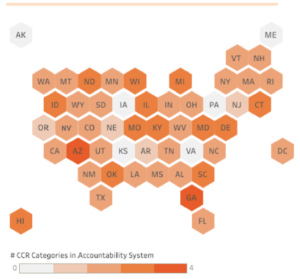 In a strong signal of support for Career Technical Education (CTE) and career readiness in high school, 40 states are now measuring career readiness in their state or federal high school accountability systems. Fewer than half as many – 17 – were measuring career readiness just five years ago.
In a strong signal of support for Career Technical Education (CTE) and career readiness in high school, 40 states are now measuring career readiness in their state or federal high school accountability systems. Fewer than half as many – 17 – were measuring career readiness just five years ago.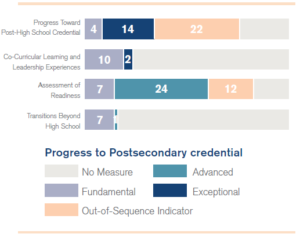 Another commonly used measure is Progress Toward Post-High School Credential. Seventeen states and the District of Columbia include measures aligned with the Destination Known recommendations, and another 22 states include out of sequence indicators. A number of states include either pathway completion or dual enrollment coursework in their accountability plans without requiring that experience to be accompanied by the completion of a state-defined college- and career-ready course of study, which is the Fundamental measurement in this category.
Another commonly used measure is Progress Toward Post-High School Credential. Seventeen states and the District of Columbia include measures aligned with the Destination Known recommendations, and another 22 states include out of sequence indicators. A number of states include either pathway completion or dual enrollment coursework in their accountability plans without requiring that experience to be accompanied by the completion of a state-defined college- and career-ready course of study, which is the Fundamental measurement in this category.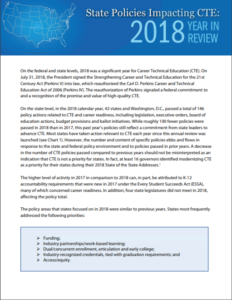 2018 was a significant year for Career Technical Education (CTE) at the federal and state levels. On July 31, 2018, the President signed the Strengthening Career and Technical Education for the 21st Century Act (Perkins V) into law, which reauthorized the Carl D. Perkins Career and Technical Education Act of 2006 (Perkins IV). The reauthorization of Perkins signaled a federal commitment to and a recognition of the promise and value of high-quality CTE. Additionally, at the state level 42 states and Washington, D.C., passed a total of 146 policy actions related to CTE and career readiness, reflecting a commitment from state leaders to advance CTE.
2018 was a significant year for Career Technical Education (CTE) at the federal and state levels. On July 31, 2018, the President signed the Strengthening Career and Technical Education for the 21st Century Act (Perkins V) into law, which reauthorized the Carl D. Perkins Career and Technical Education Act of 2006 (Perkins IV). The reauthorization of Perkins signaled a federal commitment to and a recognition of the promise and value of high-quality CTE. Additionally, at the state level 42 states and Washington, D.C., passed a total of 146 policy actions related to CTE and career readiness, reflecting a commitment from state leaders to advance CTE.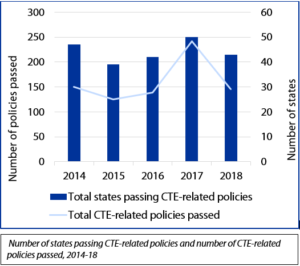 While roughly one hundred fewer policies were passed in 2018 than in 2017, this past year’s policies still reflect a commitment from state leaders to advance CTE. A decrease in the number of CTE policies passed compared to previous years should not be misinterpreted as an indication that CTE is not a priority for states. In fact,
While roughly one hundred fewer policies were passed in 2018 than in 2017, this past year’s policies still reflect a commitment from state leaders to advance CTE. A decrease in the number of CTE policies passed compared to previous years should not be misinterpreted as an indication that CTE is not a priority for states. In fact,  Students were hard at work on their laptops when we walked into the 12th grade environmental science class at Oakland High School. They were writing their senior research papers on different environmental issues in their Bay Area community, the culminating project to graduate from the Environmental Science Academy. One student was writing about the the economic impact of a diminishing bee population, another was looking into the effect of recent wildfires in northern California. And they were more than happy to show off their projects.
Students were hard at work on their laptops when we walked into the 12th grade environmental science class at Oakland High School. They were writing their senior research papers on different environmental issues in their Bay Area community, the culminating project to graduate from the Environmental Science Academy. One student was writing about the the economic impact of a diminishing bee population, another was looking into the effect of recent wildfires in northern California. And they were more than happy to show off their projects.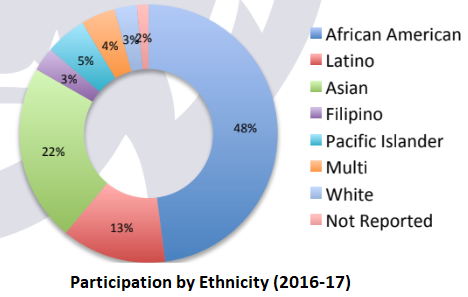 The Linked Learning approach has had a notable impact on O-High student outcomes. In 2018, 81 percent of students graduated and 70 percent enrolled in college within one year. Part of this success is attributable to the high school’s absolute focus on equity. School leaders take special care to ensure that enrollment in each pathway reflects the broader student population, with parity across ethnicity, gender and disability. And in 2010, Oakland Unified launched the Office of African American Male Achievement (AAMA) to support and develop young black males throughout the district. As a result, the African American graduation rate at O-High jumped from 58 percent in 2014 to 90 percent in 2018.
The Linked Learning approach has had a notable impact on O-High student outcomes. In 2018, 81 percent of students graduated and 70 percent enrolled in college within one year. Part of this success is attributable to the high school’s absolute focus on equity. School leaders take special care to ensure that enrollment in each pathway reflects the broader student population, with parity across ethnicity, gender and disability. And in 2010, Oakland Unified launched the Office of African American Male Achievement (AAMA) to support and develop young black males throughout the district. As a result, the African American graduation rate at O-High jumped from 58 percent in 2014 to 90 percent in 2018.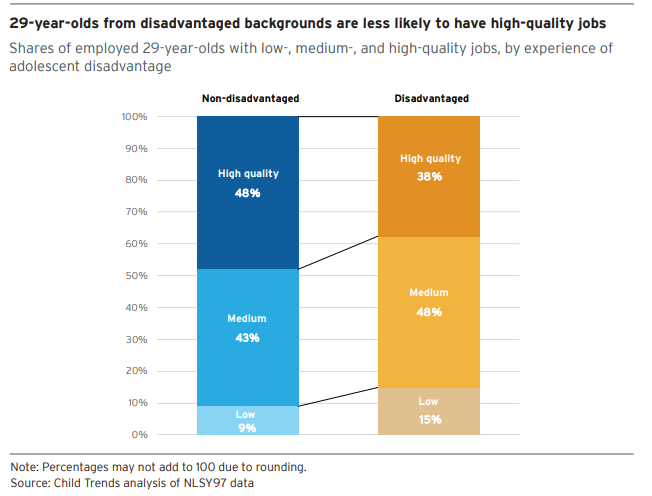 Specifically, the researchers find that participating in “relationship-focused CTE” (a term they use to refer to work-based learning and other activities where students interact with industry mentors) is significantly related to higher job quality scores at age 29. This would seem to suggest that building relationships with industry mentors and completing work-based learning at an early age can help learners, particularly low-income learners, get a leg up on their careers. While the data do not provide a full picture of the quality of work-based learning in the study, the evidence is promising.
Specifically, the researchers find that participating in “relationship-focused CTE” (a term they use to refer to work-based learning and other activities where students interact with industry mentors) is significantly related to higher job quality scores at age 29. This would seem to suggest that building relationships with industry mentors and completing work-based learning at an early age can help learners, particularly low-income learners, get a leg up on their careers. While the data do not provide a full picture of the quality of work-based learning in the study, the evidence is promising.  Earlier this summer, Advance CTE in partnership with Education Strategy Group (ESG) and the Council of Chief State School Officers (CCSSO), released
Earlier this summer, Advance CTE in partnership with Education Strategy Group (ESG) and the Council of Chief State School Officers (CCSSO), released  Livingston, Montana is a small ranching community of about 7,000, just north of Yellowstone National Park. Most of the town’s economic activity revolves around agriculture and tourism — being so close to Yellowstone brings in lots of travelers. Bozeman, which is about 30 miles away hosts a growing manufacturing and photonics industry. Despite these opportunities, students at nearby Park High School don’t always interact with industry leaders in the area, limiting their ability to explore different career options and weakening the talent pool for local business owners.
Livingston, Montana is a small ranching community of about 7,000, just north of Yellowstone National Park. Most of the town’s economic activity revolves around agriculture and tourism — being so close to Yellowstone brings in lots of travelers. Bozeman, which is about 30 miles away hosts a growing manufacturing and photonics industry. Despite these opportunities, students at nearby Park High School don’t always interact with industry leaders in the area, limiting their ability to explore different career options and weakening the talent pool for local business owners.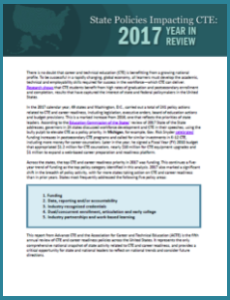 2017 was a banner year for Career Technical Education (CTE). Overall, 49 states and the District of Columbia passed a total of 241 policies related to CTE and career readiness, a marked increase from 2016. But while it is encouraging to see a groundswell of enthusiasm for CTE at the local, state and national levels, how will states leverage CTE’s momentum and ensure that state action translates to better outcomes for students?
2017 was a banner year for Career Technical Education (CTE). Overall, 49 states and the District of Columbia passed a total of 241 policies related to CTE and career readiness, a marked increase from 2016. But while it is encouraging to see a groundswell of enthusiasm for CTE at the local, state and national levels, how will states leverage CTE’s momentum and ensure that state action translates to better outcomes for students? 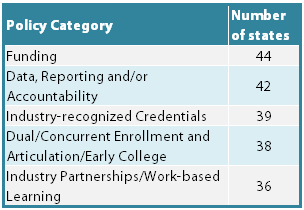 There was also a lot of activity related to data, reporting and accountability, largely due to state work around the Every Student Succeeds Act (ESSA). In 2017, 35 states identified measures of career readiness in their federal accountability systems, and many of these measures included industry-recognized credential attainment, dual-credit completion and work-based learning participation.
There was also a lot of activity related to data, reporting and accountability, largely due to state work around the Every Student Succeeds Act (ESSA). In 2017, 35 states identified measures of career readiness in their federal accountability systems, and many of these measures included industry-recognized credential attainment, dual-credit completion and work-based learning participation.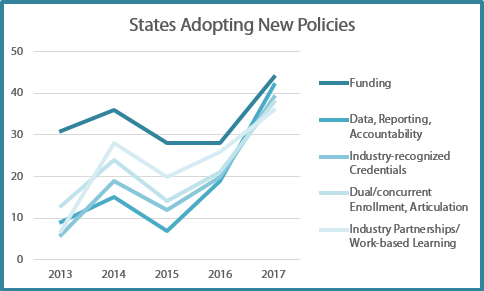
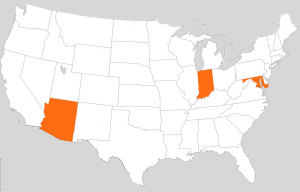 It is possible that 2017 will be a pivotal year for Career Technical Education (CTE). With
It is possible that 2017 will be a pivotal year for Career Technical Education (CTE). With  Over in the Grand Canyon State, the Arizona State Board of Education approved a comprehensive (albeit somewhat confusing) college and career readiness indicator to include in the state’s accountability system. The
Over in the Grand Canyon State, the Arizona State Board of Education approved a comprehensive (albeit somewhat confusing) college and career readiness indicator to include in the state’s accountability system. The